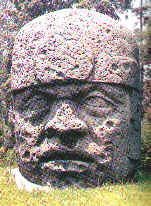|
|
Originally Mayas were different groups sharing common historical tradition. As a result their culture traits were similar, though there were specific local variations. They had similar physical characteristics and spoke languages belonging to the same linguistic stock.
Studies of Maya language have led to the conclusion that around 2500 BC there was proto-Maya group living in the area of what is now "Huehuetenango", Guatemala. Members of this group spoke what researchers have called "Proto-Maya", which in the course of time subdivided into different Mayance languages. Speakers of these languages later migrated and settled on different sites that would afterwards define Maya area and give rise to their advanced culture.
These migrations caused both the separation of different groups and their contact with other cultures. This had led to various theories about where Maya culture originated. According to some researchers, it was in the North of Tabasco and Southern Veracruz, where these groups intermingled with Olmecs.
Second theory inclines toward the opinion that it first arose in the mountains of Guatemala: The groups created agricultural society, growing corn, and then spread North and West, where they were influenced by other cultures, particularly Olmecs.
Olmec civilization is regarded as the mother culture, because it provided the basic elements for the development of other important cultures in Mesoamerica. Some of the most important cultural elements that Olmecs left to Mayas were architectural features and an elementary number and calendar system that later evolved into the accurate Maya calendar.
The chronology of Maya culture is similar to that of all Mesoamerica, although the sequence is more precise, thanks to the interpretation of its time glyphs. These have been correlated with modern calendar, and on this basis, J. Eric S. Thompson established following periods:
Formative or pre-Classic:
500 BC to 325 AD, Maya culture beings to take shape, shown particularly in anthropomorphic clay figurines, with the typical physical features of people at that time. This can be seen in the decoration of their first buildings.
Formative or pre-Classic:
325 to 925 AD. This is divided into Early Classic (325-625 AD), when external influences ended and typical features appeared, such as corbel arch and the practice of recording historical dates with glyphs. The second division is Flowering (625-800 AD), when culture was at its height in mathematics, astronomy, hieroglyphic writing, pottery, sculpture and architecture. Collapse lasted from 800 to 825 AD, when culture declined and ceremonial centers were abandoned.
Transitional or Interregnum:
925-975 AD. This marks fall in culture, almost to the level of Formative period.
Maya-Toltec or Mexica:
975-1200 AD. This was the period when influences arrived with Nahua speaking groups of Toltec culture from central Mexico; the cult of Quetzalcoatl (Kukulcan in Maya) arose. Alliances were formed between towns governed by Maya families and those ruled by families of Nahua origin.
Mexica Absorption:
1200-1540 AD. A period when several conflicts arose, the alliances were broken and warfare divided the population and impoverished the culture further. When Spanish reached Maya region, the great ceremonial centers were already abandoned and the culture was in complete decline. The first contact was in 1511, when a ship on Valdivia's expedition from Panama to Santa Domingo sank. Two survivors, Gonzalo Guerrero and Jeronimo de Aguilar, were taken prisoner by Mayas.
Guerrero adopted their customs, married, and produced family. He even fought with Mayas against his countrymen. Meanwhile, Aguilar remained slave and in 1519 joined Cortes and was one of his interpreters during the conquest of Mexico.
Yacatan was discovered by Francisco Hernandez de Cordoba in 1517; between 1523 and 1525, Pedro de Alvarado conquered the area that is now Guatemala. In 1526, Francisco de Montejo the Elder began the conquest of Yacatan peninsula and Francisco Montejo the Younger finished his father's work, founding Merida in 1542 and Valladolid in 1543. The last refugee of the ancient Mayas was Tayasal, city on lake Peten Itza, not conquered by Spanish until 1697.

|
|

